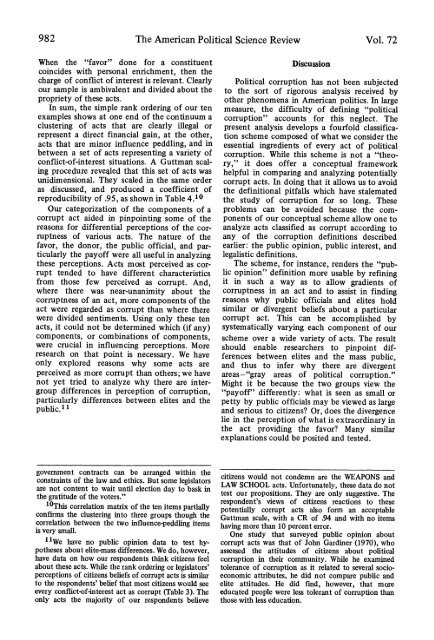Political Corruption in America: A Search for Definitions ... - See also
Political Corruption in America: A Search for Definitions ... - See also
Political Corruption in America: A Search for Definitions ... - See also
- No tags were found...
Create successful ePaper yourself
Turn your PDF publications into a flip-book with our unique Google optimized e-Paper software.
982 The <strong>America</strong>n <strong>Political</strong> Science Review Vol. 72When the "favor" done <strong>for</strong> a constituentco<strong>in</strong>cides with personal enrichment, then thecharge of conflict of <strong>in</strong>terest is relevant. Clearlyour sample is ambivalent and divided about thepropriety of these acts.In sum, the simple rank order<strong>in</strong>g of our tenexamples shows at one end of the cont<strong>in</strong>uum acluster<strong>in</strong>g of acts that are clearly illegal orrepresent a direct f<strong>in</strong>ancial ga<strong>in</strong>, at the other,acts that are m<strong>in</strong>or <strong>in</strong>fluence peddl<strong>in</strong>g, and <strong>in</strong>between a set of acts represent<strong>in</strong>g a variety ofconflict-of-<strong>in</strong>terest situations. A Guttman scal<strong>in</strong>gprocedure revealed that this set of acts wasunidimensional. They scaled <strong>in</strong> the same orderas discussed, and produced a coefficient ofreproducibility of .95, as shown <strong>in</strong> Table 4.1 0Our categorization of the components of acorrupt act aided <strong>in</strong> p<strong>in</strong>po<strong>in</strong>t<strong>in</strong>g some of thereasons <strong>for</strong> differential perceptions of the corruptnessof various acts. The nature of thefavor, the donor, the public official, and particularlythe payoff were all useful <strong>in</strong> analyz<strong>in</strong>gthese perceptions. Acts most perceived as corrupttended to have different characteristicsfrom those few perceived as corrupt. And,where there was near-unanimity about thecorruptness of an act, more components of theact were regarded as corrupt than where therewere divided sentiments. Us<strong>in</strong>g only these tenacts, it could not be determ<strong>in</strong>ed which (if any)components, or comb<strong>in</strong>ations of components,were crucial <strong>in</strong> <strong>in</strong>fluenc<strong>in</strong>g perceptions. Moreresearch on that po<strong>in</strong>t is necessary. We haveonly explored reasons why some acts areperceived as more corrupt than others; we havenot yet tried to analyze why there are <strong>in</strong>tergroupdifferences <strong>in</strong> perception of corruption,particularly differences between elites and thepublic. I IDiscussion<strong>Political</strong> corruption has not been subjectedto the sort of rigorous analysis received byother phenomena <strong>in</strong> <strong>America</strong>n politics. In largemeasure, the difficulty of def<strong>in</strong><strong>in</strong>g "politicalcorruption" accounts <strong>for</strong> this neglect. Thepresent analysis develops a fourfold classificationscheme composed of what we consider theessential <strong>in</strong>gredients of every act of politicalcorruption. While this scheme is not a "theory,"it does offer a conceptual frameworkhelpful <strong>in</strong> compar<strong>in</strong>g and analyz<strong>in</strong>g potentiallycorrupt acts. In do<strong>in</strong>g that it allows us to avoidthe def<strong>in</strong>itional pitfalls which have stalematedthe study of corruption <strong>for</strong> so long. Theseproblems can be avoided because the componentsof our conceptual scheme allow one toanalyze acts classified as corrupt accord<strong>in</strong>g toany of the corruption def<strong>in</strong>itions describedearlier: the public op<strong>in</strong>ion, public <strong>in</strong>terest, andlegalistic def<strong>in</strong>itions.The scheme, <strong>for</strong> <strong>in</strong>stance, renders the "publicop<strong>in</strong>ion" def<strong>in</strong>ition more usable by ref<strong>in</strong><strong>in</strong>git <strong>in</strong> such a way as to allow gradients ofcorruptness <strong>in</strong> an act and to assist <strong>in</strong> f<strong>in</strong>d<strong>in</strong>greasons why public officials and elites holdsimilar or divergent beliefs about a particularcorrupt act. This can be accomplished bysystematically vary<strong>in</strong>g each component of ourscheme over a wide variety of acts. The resultshould enable researchers to p<strong>in</strong>po<strong>in</strong>t differencesbetween elites and the mass public,and thus to <strong>in</strong>fer why there are divergentareas-"gray areas of political corruption."Might it be because the two groups view the"payoff" differently: what is seen as small orpetty by public officials may be viewed as largeand serious to citizens? Or, does the divergencelie <strong>in</strong> the perception of what is extraord<strong>in</strong>ary <strong>in</strong>the act provid<strong>in</strong>g the favor? Many similarexplanations could be posited and tested.government contracts can be arranged with<strong>in</strong> theconstra<strong>in</strong>ts of the law and ethics. But some legislatorsare not content to wait until election day to bask <strong>in</strong>the gratitude of the voters."10This correlation matrix of the ten items partiallyconfirms the cluster<strong>in</strong>g <strong>in</strong>to three groups though thecorrelation between the two <strong>in</strong>fluence-peddl<strong>in</strong>g itemsis very small.I We have no public op<strong>in</strong>ion data to test hypothesesabout elite-mass differences. We do, however,have data on how our respondents th<strong>in</strong>k citizens feelabout these acts. While the rank order<strong>in</strong>g or legislators'perceptions of citizens beliefs of corrupt acts is similarto the respondents' belief that most citizens would seeevery conflict-of-<strong>in</strong>terest act as corrupt (Table 3). Theonly acts the majority of our respondents believecitizens would not condemn are the WEAPONS andLAW SCHOOL acts. Un<strong>for</strong>tunately, these data do nottest our propositions. They are only suggestive. Therespondent's views of citizens reactions to thesepotentially corrupt acts <strong>also</strong> <strong>for</strong>m an acceptableGuttman scale, with a CR of .94 and with no itemshav<strong>in</strong>g more than 10 percent error.One study that surveyed public op<strong>in</strong>ion aboutcorrupt acts was that of John Gard<strong>in</strong>er (1970), whoassessed the attitudes of citizens about politicalcorruption <strong>in</strong> their community. While he exam<strong>in</strong>edtolerance of corruption as it related to several socioeconomicattributes, he did not compare public andelite attitudes. He did f<strong>in</strong>d, however, that moreeducated people were less tolerant of corruption thanthose with less education.
















